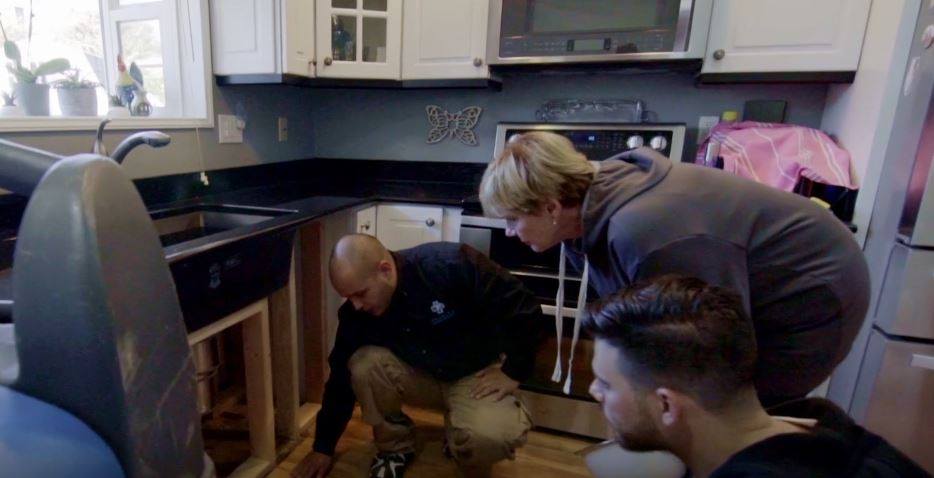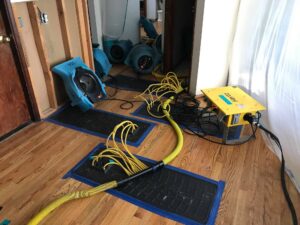- 24/7 EMERGENCY WATER DAMAGE SERVICE

Have you ever noticed a small leak in your indoor plumbing or around your appliances? It may seem like a minor puddle or small leak, but it could be a sign of water damage. Water damage can cause serious problems if not addressed promptly, from mold growth to structural damage. That’s why it’s important to know how to detect water damage in your home.
One way to do so is by using a moisture meter, which can help identify wet areas caused by water leaks or structure leakage. If you do find signs of water damage, treating it like a true emergency, mitigating the water intrusion, remediating the affected areas and repairing the damage as soon as possible can prevent further issues and save you money in the long run.
Whether you’re dealing with clean water intrusion or are in need of restoration services from disaster cleanup specialists, finding the right restoration company for your home water damage is crucial.
Take Action to Protect Your Home from Water Damage
Water damage can be caused by a variety of factors, such as floods, leaky pipes, and even a faulty faucet. As homeowners, it’s essential to inspect your home for any signs of water damage regularly. Check the walls for any discoloration or soft spots that may indicate water damage. Inspect the roof for missing shingles or other damages that could allow water to seep into your home. Check the drywall and siding around your house for any cracks or other damages that could lead to water infiltration. Cover your outside water spigots during cold weather seasons. Turn the water off to your house when you leave for vacation so the water pressure doesn’t build up in the weak points of your plumbing system and burst.
Installing proper drainage systems is crucial in preventing water damage in and around your home. One way to do this is by installing gutters on the roofline to collect rainwater and channel it away from your house. Make sure to keep gutters clean and free of debris so they don’t clog and cause overflow onto your property. Another way is by grading the ground around your house away from its foundation so that rainwater flows away from it instead of towards it. Remember, outside groundwater is defined at Category 3 (water with the most contaminants causing health issues if touched or ingested) and can cause microbial growth to form at a much quicker rate.
If you notice a sudden increase in your monthly water bill without any apparent reason, it could be an indication of a leak somewhere in your home. You can also monitor the water meter periodically by turning off all faucets and appliances that use water in the house and checking if there’s still movement on the meter. If there is movement, then there’s likely a leak somewhere that needs fixing.
Gaps between windows, doors, pipes, and walls can allow moisture to get inside your home, leading to mold growth and other forms of damage over time. Use caulk or weatherstripping to seal these gaps effectively. This will help prevent moisture from getting inside and improve your home’s energy efficiency. Tile grout, especially tile found in showers, tubs, and bathrooms, wears down over time. Moisture will eventually penetrate through the grout and often gets trapped underneath the tile affecting and deteriorating the walls and flooring.
It’s important to understand the details of your homeowner’s insurance policy when it comes to water damage. This will help you know what is covered and what is not and can save you a lot of money in the long run. It’s best to read through your policy with a Professional who has experience in this industry to help guide you and answer any questions or concerns you might have. Water Restoration Specialists are not allowed to interpret policy, but they can often answer basic and general insurance questions based on their experience.
Microbial growth is a serious problem that can occur within just days depending on the temperature of the water and the environment in the loss occurred. Mold thrives in moist environments and can spread quickly throughout your home as the spores themselves are invisible to the human eye and are airborne, causing severe damage to your property and even posing health risks to you and your family.
If you’ve experienced water damage in your home, it’s crucial to act fast and address the issue before mold has a chance to grow. This may involve drying out the affected area with airmovers, dehumidifiers or specialty equipment like air scrubbers, to remove any standing water, and disinfecting and cleaning the surfaces and air to prevent future microbial growth.
In addition to mold growth, standing water can also cause severe structural damage if left unaddressed for too long. Within just one week of sustained exposure to water, wooden structures may begin to warp or rot, while metal fixtures may corrode or rust.
To prevent this type of severe water damage from occurring in your home, it’s essential to act quickly and remove any standing water as soon as possible. This may involve using truck mount extractors, pumps or vacuums to bulk extract excess moisture from carpets, flooring, and crawlspaces, as well as drying out walls or ceilings with specialty drying equipment.
Overall, Time is of the essence. Whether you’re dealing with burst pipes or natural disasters that have caused flooding or other types of severe damage, quick action is necessary to prevent further harm from occurring.
By addressing issues like microbial growth and standing water early on and taking steps to dry out affected areas promptly, you can help mitigate the effects of severe water damage on your property. So if you’re dealing with any kind of water-related disaster in your home today, don’t wait – take action now to protect your property and prevent further damage.
Water damage can occur in your home due to various reasons such as a burst pipe, heavy rainfall, or slow leaks. The severity of water damage depends on several factors such as the type of water, temperature, and humidity levels.
Acting quickly when you notice signs of water damage in your home is essential. Even small amounts of moisture can lead to significant problems if left unaddressed.
Locating wet areas from water damage is crucial in preventing further damage.
Basements are notorious for being damp, dark, and musty. It’s no wonder they’re a common area for hidden water damage. Poor ventilation and moisture buildup can lead to microbial growth, which can cause serious health issues if left unchecked. If your basement smells musty or has visible water stains on the walls or ceiling, hidden water damage is likely lurking somewhere.
One of the first places you should check is the foundation walls. Cracks in the walls can allow water to seep in and create a breeding ground for mold. Any basement pipes or drains could leak behind walls or under floors without your knowledge.
Bathrooms are another area where water damage may be hiding. Leaks from pipes, faucets, grout failure, and toilets can go undetected for months or even years before you notice any visible signs of damage. By this time, mold may have already started growing behind walls or under floors.
To prevent hidden water damage in your bathroom, inspect all plumbing fixtures for leaks regularly. Look out for any discoloration on ceilings or walls near sinks or showers and musty smells.
Your roof is one of the most essential parts of your home’s structure since it protects everything underneath it from the elements. Unfortunately, roofs are also susceptible to leaks that can go unnoticed until significant structural or interior damages have occurred.
If you notice any discoloration on your ceiling or walls near where your roof meets them, a leak may be present. You should also inspect your attic regularly for signs of moisture buildup, such as wet insulation or microbial growth.
The first step to stopping water damage is to turn off the primary water source. This will prevent any further damage from occurring and will give you time to assess the situation. If you are unsure where the leak is coming from, turn off the main water valve to your home.
Once you have turned off the primary water source, it’s time to remove any standing water. You can use pumps or wet vacuums for this task. The longer standing water remains, the more damage it can cause. Acting quickly and removing all standing water as soon as possible is essential.
Contact professionals who specialize in repairing water damage. They can help dry out affected areas, repair damaged structures like walls and floors, and prevent future issues by identifying potential problem areas in your home. They have commercial-grade extractors to pull up greater amounts of bulk water which can often save contents, structure damage and speed up the drying process.
Acting quickly when dealing with water damage in your home is crucial. Turning off the main source of water immediately after discovering any sign of leakage or flooding is critical. Removing standing water using pumps or wet vacuums as soon as possible will also help mitigate further damage.
Finally, contacting professionals for assistance with drying out affected areas, repairing damaged structures, and preventing future issues will ensure that your home is safe from any potential harm caused by water damage. Remember that prevention is always better than cure when it comes to protecting your home from costly damages caused by leaks or flooding!
If you suspect water damage in your home, it’s important to act fast. Water damage can worsen within a week, and if left untreated, can lead to microbial growth and structural damage. Common areas where water damage may be hiding include ceilings, walls, floors, and around windows and doors.
To stop and repair water damage in your house, take action by identifying the source of the water intrusion and addressing it immediately. Depending on the severity of the damage, you may need to hire a professional restoration company.
Water damage can cause discoloration, warping, buckling or cracking. If you notice any of these signs on your wooden surfaces or newly constructed areas of your home, it’s crucial that you address the issue as soon as possible.
Remember to protect your home from future water damage by regularly inspecting pipes and appliances for leaks or malfunctions. In case of any doubt or concern about locating wet areas from water damage in your home contact a professional service provider.

We are available 24/7 and can provide the expertise and equipment needed to quickly and safely remove the water and restore your home.
Don’t hesitate to contact Premier Emergency Water Removal if you have water in your home.
Every situation is different, but Premier Emergency Water Removal has the experience and qualifications necessary to help restore your property to pre-loss condition, preventing secondary or possibly permanent damage and mold growth.
After your leak has stopped, we'll identify the affected areas that our team should target.
If you have wet carpet in your home, we'll start by extracting as much water as possible.
We'll remove your damaged carpet pad, mouldings, baseboards, as well as any wet insulation.
Our team disinfects to kill bacteria and pathogens, and to help prevent mold growth.
Finally, we'll install state-of-the-art equipment to remove moisture & monitor until its completely dry.
A: Signs of water damage include discoloration on walls or ceilings, musty odors, warped flooring or baseboards, peeling paint or wallpaper.
A: Minor cases of water damage can be repaired yourself using fans and dehumidifiers. However, major cases require professional help regulated by the IICRC.
A: It depends on the cause of the incident, but generally speaking, most homeowner insurances will cover sudden incidents like burst pipes but not negligence due to lack of maintenance.
A: Microbial growth can start forming within 24-48 hours after a leak occurs.
A: If you find mold in your home, it’s important to address the issue immediately by contacting a professional mold remediation company.
Don’t let water damage ruin your home – contact
Premier Emergency Water Removal today.
Why Choose

Our expert team is trained and experienced in dealing with all types of water damage, from minor leaks to major floods. We will quickly assess the situation and take the necessary steps to remove the water from your home and restore it to its pre-loss condition.
Fill Out The Form Below
🔒 We will not sell your information or spam you. Privacy policy
About us
Since 1998, Premier Emergency Water Removal has been helping property owners In The Greater Seattle Area recover from flood damage and water emergencies.
Contact Us
Copyright © 2025 Premier Emergency Water Removal. All Rights Reserved.